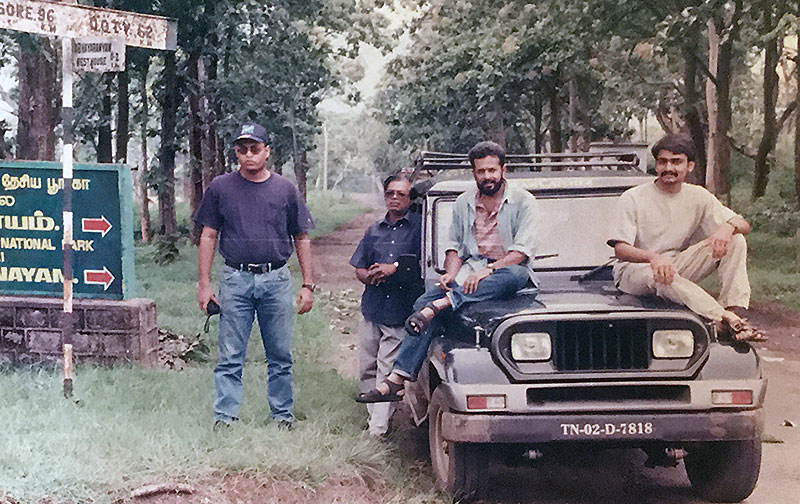Originally published in the Taj Hotels Magazine, around 1997
Kovalam is a small peaceful bay, 32 kilometers south of Madras, on the Coromandel or East Coast of India. Its tranquillity belies a history of conflict as successive trading posts were established by the Dutch, the French and the English. The ruins of a 17th Century Dutch Fort are still found scattered in the area they called “Goblon”. Today, a sleepy fishing village continues to occupy Kovalam point. With depleting fishing resources and burgeoning populations, traditional lifestyles are breaking down. In a few villages, the lure of the `quick city buck’ has ensnared entire generations.
Those that follow the old ways still depend on craft that have shown little or no change since they evolved or were invented centuries ago. Catamarans (Tamil for lashed timber ) are primitive rafts, constructed by tying together logs which are curved and shaped like a canoe. One end of the craft is shaped into a cone which rises above the water level and forms the point from where the rudder is controlled. Of the four types of traditional catamarans, the Coromandel or original Tamilnadu form is made of three to five logs. These rafts are constructed locally and watching the craftsmen at work is well worth the effort of a break in your journey.
Tourism to the discerning traveler provides the opportunity to explore and understand traditional lifestyle’s and culture, to appreciate nature and its diverse life forms, and to participate in local conservation efforts.
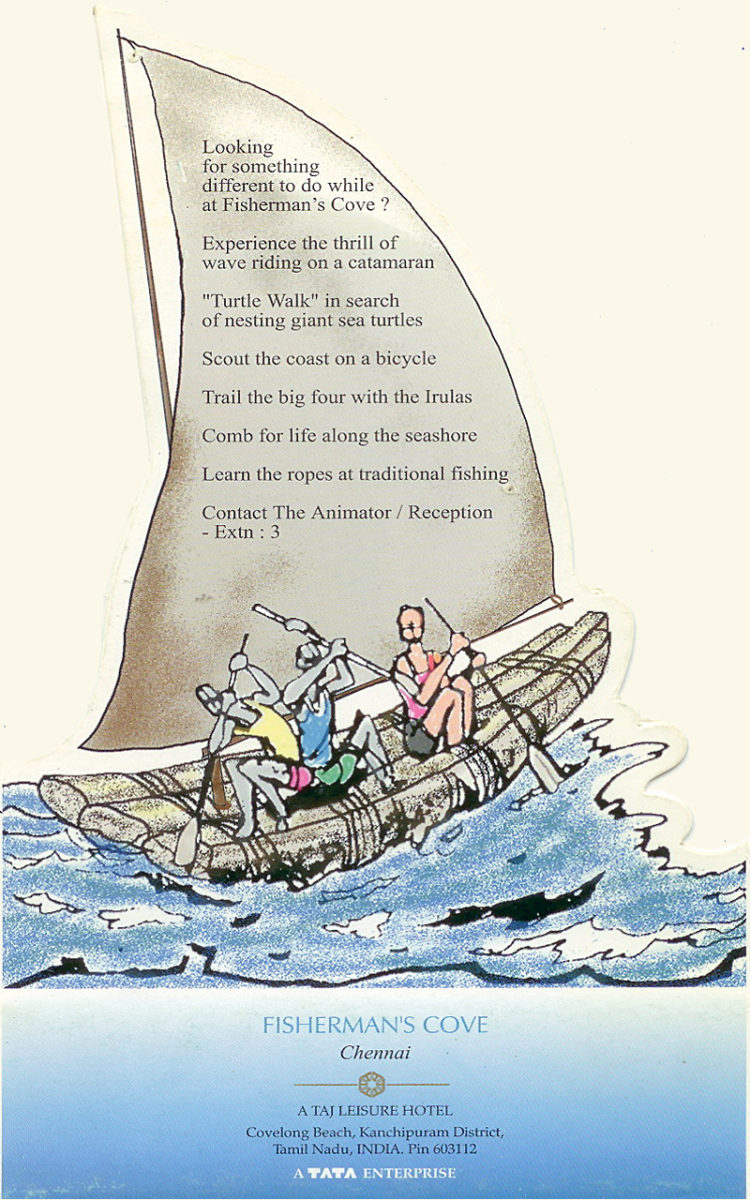
Today, Tourism provides a significant source of income. Catamaran rides have become increasingly popular. Some rather fierce altercations between competing fisherfolk led to the “Panchayat” or local government of kovalam village auctioning of the rights to a years worth of custom from domestic and foreign tourists. Integrating the interests of the local people and discerningly using the innate resources of an area, rather than importing technology is a challenge where the benefits are evident. The village as a whole has a new source of income, the experience is labour intensive and generally non-polluting and the visitor has a whale ( read-dolphin ) of a time.
Catamarans – Encounters at Sea
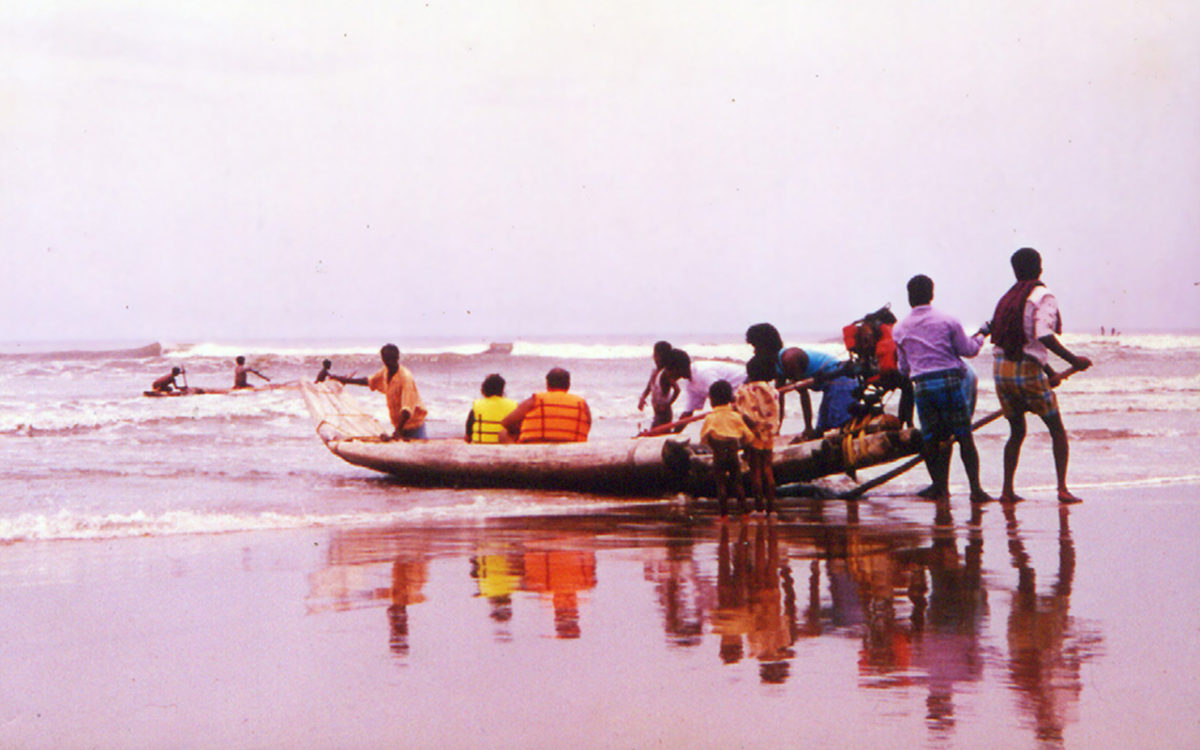
On gray mornings or sunny blue afternoons, the initial trepidation followed by the excitement of coasting the surf and the quiet peace of the point past the breakers could very well be the highlight of a holiday and for some the experience of a lifetime. The sense of quiet, the vastness, the fragility of our existence when faced with the awesome swelling power of the sea and the limitless expanse of sky can still the mind, enough cause to wonder. Quicksilver flash of flying fish, the shoals of mackerel, the dark presence of rays and the joyful abundance of dolphins – at times in gatherings of over a hundred, add life and colour to the experience
Experiences and encounters such as these are sufficient to shake us out of our indifference and to animate us enough to want to relate with the natural world, the world that the local people hold dear. And if you have a good storyteller around, India has an unparalleled fund of interlaced fact, myths and stories.
Sea Turtles – Manifestations of God
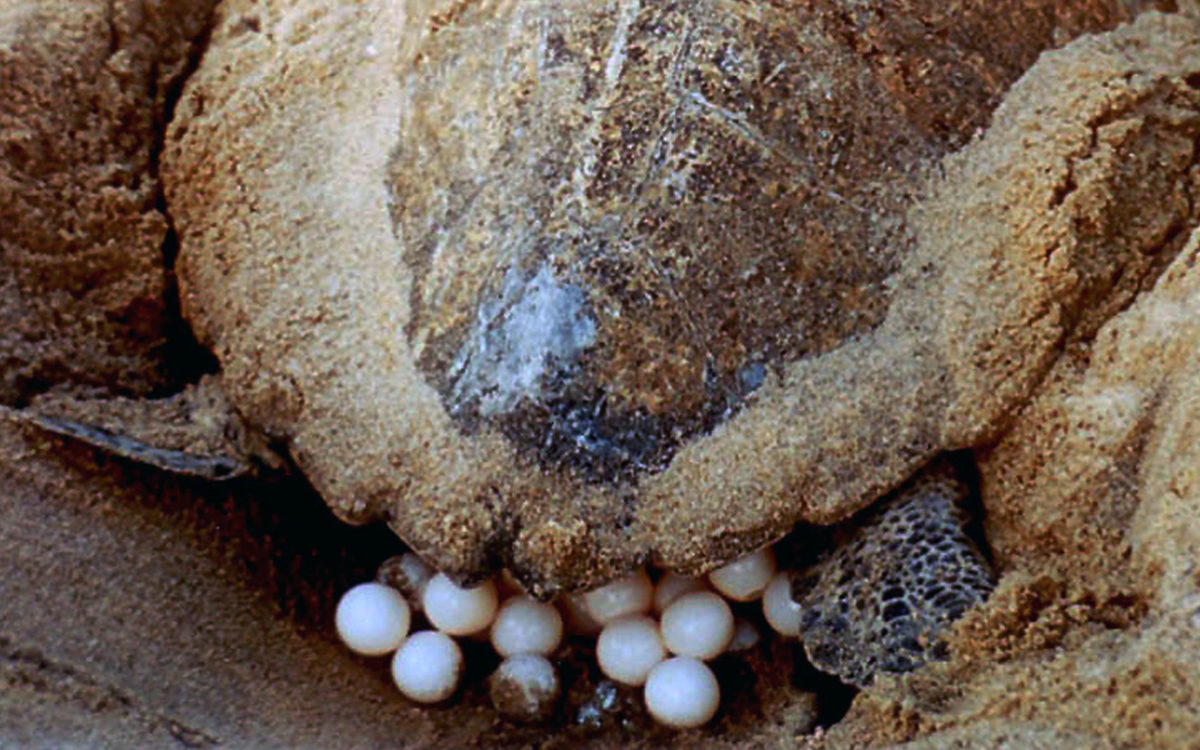
If you take a walk along the beach at night, chances are that you will cross paths with a living, breathing creature that evolved during the age of the dinosaurs- the giant sea turtle.
Sea turtles nest along the Coromandel coast. If you have been fortunate enough to have witnessed this phenomenon — of a magical creature coming ashore under cover of darkness, wet and glistening, casting sprays of white sand skywards, settling down, dancing and then quickly heading for and being swallowed up by the waves. On a dark night, with the rhythm of the sea in the background, with the wind on your face and as this ancient drama unfolds – you can not but be moved.
It was a true privilege to be present at the laying of turtle eggs. To be near enough to hear her breath, to see the eggs she was dropping into the cavity she had dug. To feel such a close contact with a free wild creature and accompany her back to the sea. We are deeply grateful for the opportunity we were given and hope that everything possible will undertaken to protect these creatures and their laying grounds. We just spent two weeks visiting Hindu temples and shrines all around Tamilnadu. Tonight’s experience is to me as true a manifestation of the presence of God.
Anne Bridge, 5th February, 97, Sotheby’s SOAS Group
The belief that Sea Turtles are manifestations of God is not new. Turtles have been revered since time immemorial by traditional fishing communities as an Avatar of Vishnu, About a decade ago, a fortunate or unfortunate mama-turtle on her quest for a nesting site fell down the steps and into the Kapaleeshwar Temple near Madras. She promptly became the object of worship and was later guided back to sea
Of the Eight living sea turtle species of the world, the smallest – the Olive Ridley, Lepidochelys olivacea, is the most common nesting species on the east coast of India. Arriving each year, around the onset of the North East monsoon, hundreds of these animals, both males and females instinctively congregate off the beaches where they had hatched a few years earlier. The homing mechanism that enables them to locate the beach where they hatched after a journey of a few thousand kilometers, with an accuracy of a few kilometers, and sometimes a few meters – remains a mystery.
The adult nesting females about a meter in length, after running a gauntlet of mechanised trawlers, drift nets and the surf comes ashore under cover of darkness. She hauls her now heavy body above the high water line and with some instinct and sometimes after a few abortive beginnings proceeds to excavate a flask shaped nest. Into this goes anywhere between 60 & 200 eggs. She fills up the pit with sand and then uses her hard armoured underbelly to pack it in. She appears to be dancing and this is a truly delightful spectacle. The show is not over. She then throws sprays of sand with her long wing like fore flippers all over and around the area – very effectively camouflaging the nesting site.
Seven weeks later the matchbox sized hatchlings arrive, nurtured by the sun that warms the earth. When all or most of them have hatched, they begin to shovel sand together till there is a flow of sand downwards and a wave of baby turtles upwards. They wait again, just beneath the surface till nightfall, emerge together and head for the sea.
The large number of eggs laid within a season offsets heavy predation levels at egg, hatchling & juvenile stages. It is estimated that only one out of a hundred eggs laid actually survive till adulthood, but this has been enough to ensure the survival of the species. This survival strategy is, however extremely fragile and loss of nesting habitats, pollution and poaching may tilt the scales towards extinction. Global warming has implications in the lives of sea turtles that are inconceivable to most of humanity. Sex of the hatchlings are deter mined by temperature. It has been documented that hotter sand favors faster incubation and tends to enhance production of female hatchlings leading to imbalanced sex ratios in sea turtle populations and a subsequent decline of the species.
India and Indians have always had an innate empathy with the natural world. That this empathy was inherited was fact until a couple of generations ago.
The thought of harming a sea turtle was unheard of, considered taboo among communities that made their living from the sea. But then things changed. Walking the beach one night – we came across a fresh carcass with a strange flesh wound. Questioning the locals revealed that a young, inebriated fisherman had disturbed her just before she nested, When she began retreating to the sea – he hauled her ashore, cut her side open and relieved her of her as yet un-layed eggs. She probably died later at sea. We recovered a few dozen of her eggs from the shamed elders in the village – most of which failed to hatch.
Since the early seventies, a number of organisations including the Madras Snake Park Trust, The Central Marine Fisheries Research Institute (CMFRI) and the Tamil Nadu Forest Department have been involved in Sea Turtle Conservation along the Coromandel coast.
In the late eighties a small obscure, ever changing group – The Student’s Sea Turtle Conservation Network (SSTCN) was formed. Since then, each year a hatchery is constructed and the group endeavors to rescue and relocate sea turtle nests that are in danger. You can join them during season (December – March) on the Ridley Trail.
Banking on Crocodiles
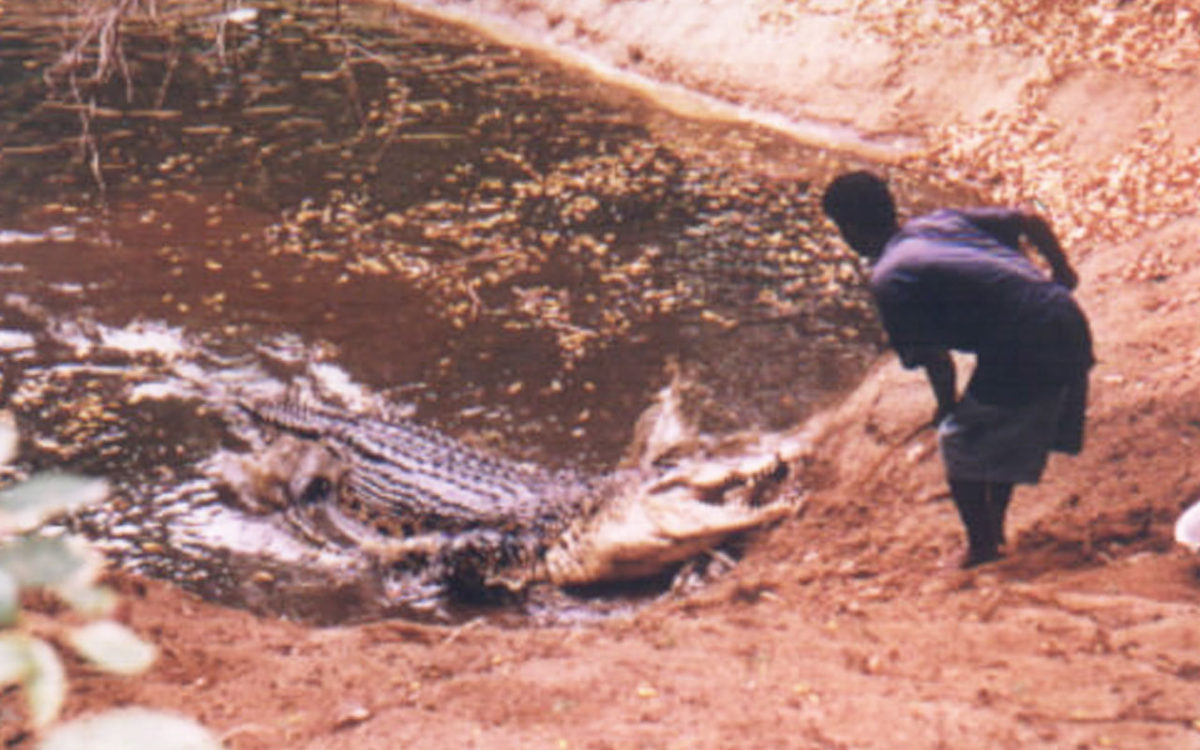
Just six kilometers south of Kovalam, lies the village of Vadanemmeli. Vadanemmeli was just another unknown settlement till the Madras Crocodile Bank was founded in 1972 by Romulus Whitaker, the man often referred to as the “pambu karan “ (snakeman) from Tamil Nadu.
Formed in response to dwindling crocodilian numbers in the wild, as a result of poaching and the rapid disappearance of natural habitat, the bank originally envisioned breeding for release in protected areas. The effort that went into bringing the Croc Bank into being and sustaining it through the years has borne fruit as evidenced by the number of species that are breeding in this facility.
The Croc Bank has not been able to elicit much sympathy for their back to the wild programmes or for the culling of excess animals for meat and for skin. Bureaucratic understanding, protected habitats and sympathetic local populations being few and far between, the Croc Bank bank is today burdened with hundreds upon hundreds of these reptiles. The finances required to maintain and feed these increasing numbers, though offset to an extent by tourism revenues, is still as has always been, elusive. These issues are crucial in terms of addressing the socio-economic rationale for conservation.
Tourist arrivals to this little island of green is in the thousands drawn by the unexplained human fascination for things that crawl. Besides the three Indian species including the endangered Gangetic Gharial, the Croc Bank is home to a bewildering number of exotic species. In believing that education is vital to conservation, imaginatively created signboards are everywhere. Researcher-guides are usually available to walk the discerning visitor around. An insight into research & conservation activities, watching crocodiles tear into their feed, and getting to touch or hold a “baby croc” can be some of the experiences during a visit to the Crocodile Bank.
Today, global warming, the depletion of the ozone layer, loss of forests and the survival of the seas have become an integral part of human, political and even industrial agendas. The fate of the Earth, of creatures such as the dolphin and the seemingly insignificant mole-crab – simply reflect the influence of human attitudes. Contradictory to what is commonly believed, Conservation isn’t something just biologist or environmentalists do – it is an activity that is conceived, initiated, evaluated and impeded by all of humanity. We need to come to terms with the fact that our environment is a composite, often contradictory, sometimes incompatible from the human perspective but by and large unavoidable and therefore all efforts have to be made to integrate our systems in our search for solutions to life on this our small planet.
On the Trail of the Big Four
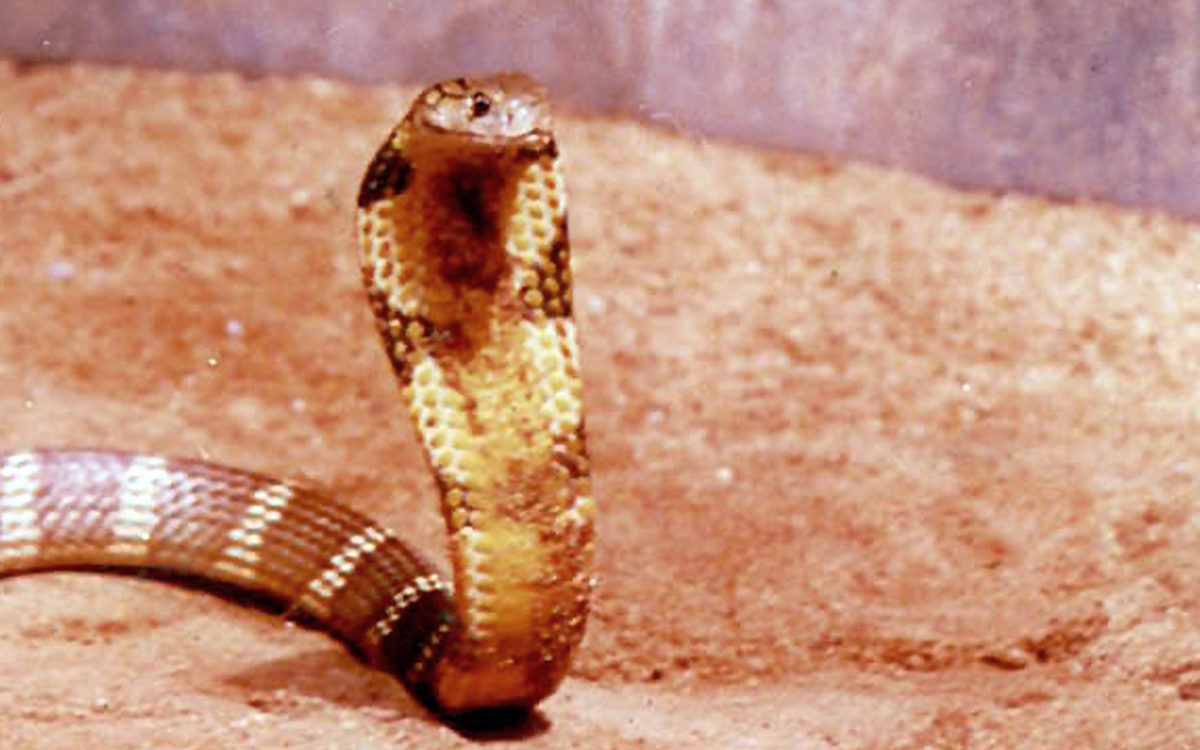
Within the premises of the Crocodile Bank is this rather special society that directly contributes to saving human lives, preserving traditional ways and at the same time taking no toll on the environment. Another of Whitaker’s children – The Irula Snake Catcher’s Industrial Cooperative Society was formed in 1978.
The Irulas of Tamilnadu, hunter-gatherers traditionally specialized in catching by hand, snakes and rats from agricultural lands. They help farmers rid fields of thousands of these pests, a non-toxic low impact method of dealing with the problem of massive losses of produce each year.
Beneath a large thatched shelter with waist high walling separating the viewers from the pit, sits over 500 earthen pots of the household variety. Each pot contains a mature snake. All four of India’s venomous snakes, the Cobra, the Russels viper, the Saw Scale Viper and the Common Krait are caught under a permit issued by the Department of Forests.
Experienced handlers grasp the snake very firmly behind the head and allow the fangs to pierce a membrane stretched over a glass vial. Gentle stimulation causes the venom from the glands on the side of the head to collect in the container. Each snake is milked once a week and released after a month. The Venom is supplied to institutes such as the King’s institute in Chennai, The Haffkine Institute in Pune, the central Research institute in Shimla where anti-venin serum is prepared.
This far sighted programme has resurrected the Irula’s occupation, preserved their heritage and also plays a very significant role in the production of polyvalent Anti-venin serum for the medical world.
Joining Irula families on the trail of the big four falls somewhere betwen a truly truly learning experience and an outright adventure.
To the curious, the discerning and the alternative traveler, Kovalam has much more to offer – the opportunity to try your hand at traditional fishing, to visit salt pans & purifying factories, Shrimp farms,
to cycle by an old British bungalow which still houses a car fueled by coal, the Eashwaran temple where rumour has it that anyone who goes inside faces death and never comes out, the Vanian Chavadi Choultry – a resting place of pilgrims in days gone by, and for those who are so inclined a visit to the Nitya Kalayani Temple of marriage.
Tourism to the discerning traveler provides the opportunity to explore and understand traditional lifestyle’s and culture, to appreciate nature and its diverse life forms, and to participate in local conservation efforts.
Today, global warming, the depletion of the ozone layer, loss of forests and the survival of the seas have become an integral part of human, political and even industrial agendas. The fate of the Earth, of creatures such as the dolphin and the seemingly insignificant mole-crab – simply reflect the influence of human attitudes. Contradictory to what is commonly believed, Conservation isn’t something just biologist or environmentalists do – it is an activity that is conceived, initiated, evaluated and impeded by all of humanity. We need to come to terms with the fact that our environment is a composite, often contradictory, sometimes incompatible from the human perspective but by and large unavoidable and therefore all efforts have to be made to integrate our systems in our search for solutions to life on this our small planet.
The Taj Group’s Fisherman’s Cove Beach Resort, landscaped around the Dutch ruins at Kovalam , in response to the needs of out times utilises non-conventional energy sources for its hot water requirements; A desalination plant for day to day operations and vapour absorption Non-CFC based machines for refrigeration.


